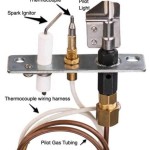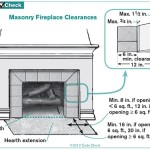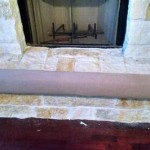Air Conditioner Exhaust Fireplace: Exploring a Novel Concept
The concept of an "air conditioner exhaust fireplace" is a theoretical proposition that explores the potential of repurposing the waste heat generated by air conditioning systems. Traditional air conditioning units function by transferring heat from inside a building to the outside environment. This process results in a significant amount of exhaust heat being released, which is typically dissipated into the atmosphere. The notion of an air conditioner exhaust fireplace envisions capturing and utilizing this waste heat to provide supplemental heating, potentially mimicking the aesthetic and functional aspects of a traditional fireplace.
Currently, there is no readily available, commercially produced "air conditioner exhaust fireplace" as a standard product. The concept remains largely theoretical and experimental. However, the principles behind it are rooted in established engineering and thermodynamic concepts related to heat transfer, energy recovery, and building climate control.
The implementation of such a system would involve several key components: the air conditioning unit itself, a heat exchanger to capture the exhaust heat, a distribution system to transfer the heat to a designated area, and potentially a visual element to simulate a fireplace aesthetic. The complexity and efficiency of such a system would depend on various factors, including the size and type of air conditioning unit, the design of the heat exchanger, and the insulation and ventilation characteristics of the building.
Exploring the Potential Benefits
The primary potential benefit of an air conditioner exhaust fireplace is energy efficiency. By capturing and reusing waste heat, the system could reduce the overall energy consumption of a building. This would translate to lower energy bills and a reduced carbon footprint. In climates that experience both cooling and heating seasons, this type of system could offer a more sustainable approach to climate control.
Another potential advantage is the reduction of heat island effect in urban areas. Air conditioning systems contribute to the urban heat island effect by releasing large amounts of heat into the surrounding environment. By capturing and redirecting this heat, an air conditioner exhaust fireplace could potentially mitigate this effect, contributing to a more comfortable outdoor environment.
Furthermore, the system could offer a unique aesthetic appeal. While the primary function is heat recovery, the visual element of a simulated fireplace could provide a sense of comfort and ambiance, similar to a traditional fireplace. This could be particularly appealing in climates where a traditional fireplace is not practical or efficient.
Addressing the Technical Challenges
The development of a viable air conditioner exhaust fireplace faces several technical challenges. One of the primary challenges is the design of an efficient and cost-effective heat exchanger. The heat exchanger must be able to effectively capture the heat from the air conditioning exhaust without significantly impacting the performance of the air conditioning unit. This requires careful consideration of materials, surface area, and airflow dynamics.
Another challenge is the distribution of the recovered heat. The system must be able to efficiently transport the heat from the heat exchanger to the designated area for heating. This may involve the use of ducts, fans, or other heat transfer mechanisms. The design of the distribution system must consider factors such as heat loss, air leakage, and noise levels.
Safety is also a paramount concern. The system must be designed to prevent overheating, fire hazards, and other potential safety risks. This requires the implementation of appropriate safety controls, such as temperature sensors, pressure relief valves, and automatic shut-off mechanisms.
Understanding the Thermodynamic Principles
The operation of an air conditioner exhaust fireplace is governed by the principles of thermodynamics, specifically the laws of heat transfer and energy conservation. The air conditioning unit functions according to the refrigeration cycle, which involves the transfer of heat from a cooler space to a warmer space using a refrigerant.
The exhaust heat generated by the air conditioning unit is a byproduct of this process. The heat exchanger captures this exhaust heat and transfers it to a working fluid, such as air or water. The heated working fluid is then circulated to the designated area for heating, where it releases its heat into the surrounding environment.
The efficiency of the system is determined by the effectiveness of the heat exchanger and the distribution system. A highly efficient heat exchanger will capture a larger percentage of the exhaust heat, while an efficient distribution system will minimize heat loss during transport. The overall energy savings will depend on the extent to which the recovered heat can offset the need for other heating sources.
In conclusion, the air conditioner exhaust fireplace is a intriguing concept with the potential to improve energy efficiency and reduce environmental impact. While significant technical challenges remain, ongoing research and development in heat transfer technologies and building climate control may pave the way for practical implementations in the future. The successful realization of this concept would require a multidisciplinary approach, involving expertise in mechanical engineering, thermodynamics, and building design.

How To Install A Portable Air Conditioner 10 Steps

What Is A Direct Vent Fireplace How Does Work

Fireplaces And Wood Stoves Have Proper Ventilation Building America Solution Center

Can You Use A Portable Air Conditioner Without The Hose Pickhvac

Longwell 100mm Ac 230v Fireplace Electric Cross Flow Fan Blower 220v With Sd Control For Air Conditioner Ventilation Oven China Tangential Made In Com

How To Vent A Portable Air Conditioner Without Window American Home Water

How To Vent A Portable Air Conditioner Sylvane
Is There A Way To Provide Fresh Air Intake From The Outside For Typical Brick Residential Fireplace On An Exterior Wall Quora

How To Vent A Portable Air Conditioner Without Window

What To Do About Wood Burning Fireplaces And Indoor Air Quality Vito Services
Related Posts








